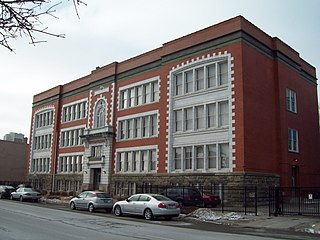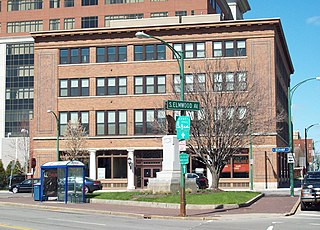
United Office Building, now known as the Giacomo, is a historic Mayan Revival, a subset of art deco, skyscraper in Niagara Falls, New York, US.

Electric Tower is a historic office building and skyscraper located at the corner of Washington and Genesee Streets in Buffalo. It is the seventh tallest building in Buffalo. It stands 294 feet (89.6 m) and 14 stories tall and is in the Beaux-Arts Classical Revival style. It was designed by James A. Johnson and built in 1912. The tower was based upon an earlier Electric Tower constructed for the 1901 Pan-American Exposition; as with most of the buildings constructed for that event, the original was only temporary and demolished shortly after the fair ended. Additions were made in 1923 and 1928. The white terra-cotta clad was originally built as the Niagara Mohawk Building and features an octagonal tower which steps back three times to terminate in a large lantern. It is also known as Iskalo Electric Tower, for the real estate development company that owns the building.

School 13, also known as Boys Vocational High School and Buffalo Alternative High School, is a historic school building located at Buffalo in Erie County, New York. It was built about 1915, and is a three-story, steel framed building sheathed in brick and terra cotta with Beaux-Arts style design elements. The "T"-shaped building housed administrative offices, classrooms, a gymnasium, swimming pool, and two-story auditorium. The building housed a school until 2003.

Hotel Lafayette, also known as the Lafayette Hotel, is a historic hotel building located at Buffalo in Erie County, New York.

The Twentieth Century Club is a women's social club founded in the late 19th century in Buffalo, New York. It is located at 595 Delaware Avenue, in the Delaware District neighborhood. It was the first club run by women, for women, in the United States.

The Astral Apartments is an apartment building located at 184 Franklin Street in Greenpoint, Brooklyn, New York City. The Astral was built in 1885–1886 as affordable housing for employees of Charles Pratt's Astral Oil Works. It is a block-long brick and terra cotta building in the Queen Anne style. It features a central projecting section with a deep, three-story-high round arch recess. The roof features inward-looking decorative grotesques. Original amenities of the building included a settlement house, library, and kindergarten.

Buffalo Smelting Works is a historic copper smelting complex located in the Black Rock neighborhood of Buffalo in Erie County, New York. It was built in 1891, and consists of a twinned, 2 1/2-story, brick building. It is topped by pitched roofs and clerestories. The industrial building reflects Romanesque Revival design. The building is the only element left from the smelting complex originally built by the Calumet and Hecla Mining Company. The property was acquired by the American Radiator Company in 1920, and is now part of a marina.

Robertson–Cataract Electric Building, also known as The Corn Exchange and 100 South, is a historic commercial building located in downtown Buffalo in Erie County, New York. It was built in 1915–1916, and is a four-story, five bay, reinforced concrete building faced in brick in the Renaissance Revival-style. The building was expanded in 1919. It features terra cotta and polychromatic brick details in hues of red, brown, and purple. It originally housed a retail showroom and warehouse space for the Robertson–Cataract Electric Co.
Esenwein & Johnnson was an architectural firm of Buffalo, New York.

The New Kasson Apartments is a historic apartment building located on James Street in the Near Northeast neighborhood of Syracuse, Onondaga County, New York. It was designed by architectural firm of Merrick and Randall and built in 1898. It is a seven-story, Renaissance Revival style building consisting of two rectangular multi-story blocks. It is a yellow brick and limestone building with cast stone and terra cotta details. The facades features projecting three-sided bays extending from the first through fifth floors. It is located across from the Leavenworth Apartments built in 1912.

State Bank of Hammond Building is a historic bank building located at 5444-5446 Calumet Avenue in Hammond, Lake County, Indiana. It was built in 1927, and was designed by Chicago architects Vitzthum & Burns. It is a two-story, Classical Revival style brick, concrete, and steel building on a full basement. The front facade is faced in terra cotta and features a colossal entry portico with two engaged square columns and two fluted round columns. The Northern States Life Insurance Company ceased operation in 1931, and the building subsequently housed the Calumet State Bank from 1933 until 1935, and later a license bureau and other retail and office uses.

Citizens' Trust Company Building, also known as the Sycamore Building, is a historic office building located at Terre Haute, Vigo County, Indiana. It was designed in 1920 by the local firm of Johnson, Miller & Miller and built in 1921–1922, and is a 12-story, Chicago school style steel frame building sheathed in brick. It features stone and terra cotta detailing and Art Deco style design elements. The building was built to house the main office of the Citizens' Trust Company.

Fidelity Trust Building is a historic bank building located in Indianapolis, Indiana. It was built in 1914–1915, and is an eight-story rectangular Classical Revival style building faced in white glazed brick and terra cotta. It measures 39 feet (12 m) wide by 110 feet (34 m) deep. At the time of its listing, the building housed J. Pierpont's Restaurant and Bar.

Marott's Shoes Building is a historic commercial building located at Indianapolis, Indiana. It was built in 1899–1900, and is a seven-story, four bay, rectangular, Tudor Revival style building faced in white terra cotta. It has large Chicago style window openings on the upper floors. It features Tudor arched windows on the top floor and a crenellated parapet. It is located next to the Lombard Building.

Indianapolis News Building, also known as the Goodman Jewelers Building, is a historic commercial building located at Indianapolis, Indiana. It was designed by architect Jarvis Hunt (1863–1941) and built in 1909–1910. It is a ten-story, rectangular, Neo-Gothic style brick and terra cotta building. It is three bays wide and 10 bays deep. The top floor features a corbelled terra cotta balcony, Tudor-like window openings, and a Gothic parapet. It is located next to the Taylor Carpet Company Building. The building housed the Indianapolis News until 1949.

Selig's Dry Goods Company Building, also known as Morrisons/Em-roe Sporting Goods Company, is a historic commercial building located at Indianapolis, Indiana. It was built in 1924, and is a seven-story, rectangular, Beaux-Arts style building with a white terra cotta and aluminum front facade. It was remodeled in 1933. The building features tinted plate glass windows and a terra cotta Roman thermal window-like screen at the top floor. The building housed the Selig's Dry Goods Company, in operation until 1933.

The Seville was a historic apartment building located at Indianapolis, Indiana. It was built in 1921, and was a three-story, "C"-shaped, building on a raised basement. It featured elaborate Spanish-influenced terra cotta ornamentation and a wide overhanging stamped tin boxed cornice. It has been demolished.

Saint James Court is a historic apartment complex located at Indianapolis, Indiana. It was built in 1919, and consists of two 3 1/2-story, Renaissance Revival style buildings. The buildings are faced in thick stucco and feature terra cotta panels with bas relief decoration.

Buffalo Public School No. 24, also known as Public School 59, is a historic school building located in the Broadway-Fillmore neighborhood of Buffalo, Erie County, New York. The original section was built in 1901, and is a three-story, seven bay, "I"-shaped, red brick building over a raised basement with Renaissance Revival detailing. The building incorporates sandstone, terra cotta, and pressed metal details. It was the first school to offer special education within the City of Buffalo school system. The school has been redeveloped as an apartment building.

Buffalo Public School No. 44, also known as Lincoln School, is a historic school building located in the Lovejoy neighborhood of Buffalo, Erie County, New York. The original section was built in 1907, and is a three-story, red brick, "E"-shaped building with Renaissance Revival detailing. Major additions were made to the original building in 1930 and 1975. Architectural details include Onondaga limestone trim and Ionic pilasters with red terra cotta bases and capitals. The building reflects the evolution of standardized urban public school designs in the early 20th century.























